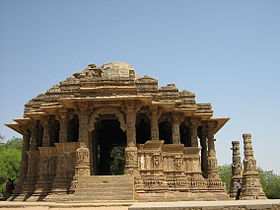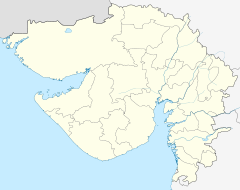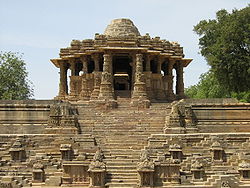- Sun Temple, Modhera
-
Sun Temple, Modhera Coordinates: 23°25′N 72°22′E / 23.42°N 72.37°ECoordinates: 23°25′N 72°22′E / 23.42°N 72.37°E Name Proper name: Sun Temple, Modhera Location Country: India State: Gujarat District: Mehsana Location: Modhera Architecture and culture Primary deity: Surya Architectural styles: Solanki History Date built:
(Current structure)1026 The Sun Temple, Modhera, at Modhera in Gujarat, is a temple dedicated to the Hindu Sun-God, Surya. It was built in 1026 AD by King Bhimdev of the Solanki dynasty. Other Sun Temples in India are as follows: Konark in Orissa, Martand in Jammu and Kashmir near Almora in Uttarakhand, Dakshinaarka temple in Gaya, Bihar, Punark and Deo Barunark in Bihar, Bhramanya Dev Temple at Unao, Balaji in Madhya Pradesh, Sun Temple at Sri Surya Pahar in Assam, Suryanaar Temple at Kumbakonam in Tamil Nadu, Surya Narayana Swamy temple at Arasavalli in Andhra Pradesh.
The Modhera sun temple is situated on the bank of the river Pushpavati, 25 km from Mehsana and 102 km from Ahmedabad.
Contents
History
According to the Skanda Purana and Brahma Purana, the areas near Modhera were known during ancient days as Dharmaranya (literally meaning the forest of righteousness). According to these Puranas, Lord Rama, after defeating Ravana, asked sage Vasistha to show him a place of pilgrimage where he could go and purify himself from the sin of Brahma-hatya (the sin of killing a Brahmin, because Ravana was a Brahmin by birth). Sage Vasistha showed him Dharmaranya, which was near the modern town of Modhera. In the Dharmaranya, he settled at a village Modherak and performed a yagna there. Thereafter he established a village and named it Sitapur. This village is about 15 km from Becharaji Modherak village and it subsequently came to be known as Modhera.
The Sun Temple was built by Rushabh Bhimdev I of Solanki Dynasty in AD 1026. This was the time when Somnath and the adjoining area was plundered by Mahmud Ghazni and reeled under the effects of his invasion. The Solankis, however, regained much of their lost power and splendour. Anahilvad Patan, the Solanki capital, was restored to glory. Royalty and traders jointly contributed to build grand temples.
Solankis were considered to be Suryavanshis, or descendants of Sun god. The temple was so designed that the first rays of the sun fell on the image of Surya, the Sun God, at the time equinoxes.
The temple is partially in ruins after it was also finally destroyed by the Allauddin Khilji.
However, enough has remained of the temple to convey its grandeur.
Architecture
The Sun temple is of a unique architecture of its own kind.
The temple comprises three separate but axially-aligned and integrated elements.
- Surya Kund, which is an intricately carved, stepped tank named after Sun god Surya.
- Sabha Mandap, which is a hall used for religious gatherings and conferences.
- Guda Mandap, i.e. sanctum sanctorum, which once housed the idol of Sun God.
Surya Kund
This Suryakunda also known as Ramakunda is a large rectangular stepped tank measuring 53.6 x 36.6 meters under the east face of sabhamandap used to store pure water. Devotees were required to perform ceremonial ablutions here before worshiping the Sun God.
The Suryakund is finest example of geometry. The organization of stone into composition gives shape to a dazzling pattern of art. It is proportioned with innumerable stone steps leading devotees down to its base. 108 miniature shrines are carved in between the steps inside the tank. Also number 108 considered to be auspicious by Hindus as hindu rosary has same number of beads.
Reservoir Deities
There are four terraces to descend in order to reach the bottom of the tank. Small pyramid shaped steps are for each terrace. God & Goddess depicted in immortalized stone, unfold the sculpture wealth. Lord Vishnu, Lord Ganesh, Lord Natraj, Sitlamata presence a marvel created during Solanki era.
Two Huge ornamental arch called Toran forms a Gate-Way to Sabha Mandap literally meaning assembly hall.
Sabha Mandap
This hall of religious gatherings is a magnificent pillared hall. It is open from all sides and has 52 intricately carved pillars representing 52 weeks in a year. The carvings depict various episodes from the Hindu epics of Ramayan, Mahabharat and Krishna Lila (i.e. story of lord Krishna).
Between the Sabha Mandapa and the sanctum sanctorum is a beautiful hall with pillars and arches, whose facade has been renovated and partially redone, and the walls have 12 niches showing the different aspects of the Sun God in each month.
Sanctum Sanctorum
This is called the main temple or the sanctum sanctorum of the temple. Lotus opens with sunrise and closes itself with sunset. Hence, it is considered to be sun's flower. The entire temple is therefore based on an inverted lotus-base plinth. It was designed such that the rays of the rising and setting sun on the day of equinox (length of day and night is nearly equal - 20 March and 21 September generally), fell on the bejeweled pure gold idol of Sun riding on his chariot driven by Saarthi Arun. Sun's chariot has 7 horses and Saarthi Arun sits on the 4th horse. The entire idol made of gold (including the charioteer,chariot and horses) was placed on a pit that was 15 feet deep and filled with gold coins. It was built by the Solankis in honour of their ancestral God. It was plundered by Mahmud Gazni.
Exterior
The exterior of the temple walls has 12 different postures of Adityas - Sun God along with eight Dikpals, Lord Vishwakarma - who constructed Golden Dwarka city for Shri Krishna, Varundev - God of Air, Agnidev - God of Fire, Ganesh - God for starting, Mata Saraswati - Goddess of Education & Wisdom. Also seen Samundramanthan.
Erotic Sculptures
Even today to talk of sex in sacred place is akin to religious blasphemy. All important religious sects of the country like Hinduism, Buddhism, & Jainism have presented erotic motifs in their art . In the days when temple was built, sex was neither suppressed nor moralized. It was seen as an act that brought about fertility. Hence at this temple a most profound depiction of sexual iconography is displayed, at the exterior walls of the main temple itself.
Modhera Dance Festival
To create the enchantment and splendor of our ancient history and rich cultural traditions; Modhera dance festival is scheduled to be held during the third week of January every year, after the festival of Uttarayan for three days in the backdrop of the Sun temple. Renowned Indian artist perform here and enthrall the audience. The objective is to present classical dance forms in an atmosphere they were originally presented in. The festival is organised by the Tourism Corporation of Gujarat.
Walking Tour
With prior appointment walking tour in the premises can be organised. "A Tribute to the craetor of life, carved with passion in stone"
- Photo Gallery
See also
- Modhera Dance Festival
- Becharaji
- Patan, Gujarat
References
- Lobo, Wibke, The Sun-temple at Modhera: A monograph on architecture and iconography (Forschungen zur allgemeinen und vergleichenden Archäologie)
- Burgess, Jas & Cousens, Henry, The Architectural Antiquities of Northern Gujrat, Bharatiya Publishing House, Varanasi, 1975
- Brown Percy, Indian Architecture (Buddhist and Hindu Periods), D.B. Taraporewala Sons & Co. Ltd. Bombay, 1975
- Sankalia, Hasmukh. D., The Archaeology of Gujarat (Including Katiawar), Natwarlal & Co. Publishers, Bombay, 1941
- Majumdar, Ashok Kumar, Chaulukyas of Gujarat, Bharatiya Vidya Bhawan, 1956.
- an inside look at the glorious sun temple at modhera, published by TCGL, Gandhinagar, 2001.
Further readings
- Surya: The God and His Abode, Parijat, 2010, ISBN 8190356178
External links
- Modhera sun temple at Gujarat government tourism site
- A Book website related to Indian architecture. Contains nice photos of the temple
- A tourist website
- Ahmedabad city website
- 21st March brings special sunrise to Modhera Sun temple
- Glow of the setting sun on the temple
Hindu Temples in Gujarat Akshardham (Gandhinagar) • Ambaji • Becharaji Temple • Camp Hanuman Temple • Chotila • Dwarakadheesh Temple • Pimpleshwar Mahadev, Saldi • Santram Mandir • Shamlaji • Shri Hanuman Mandir, Salangpur • Shri Nathjidada Ni Jagya • Shri Swaminarayan Mandir, Ahmedabad • Shri Swaminarayan Mandir, Bhuj (New temple) • Shri Swaminarayan Mandir, Bhuj • Shri Swaminarayan Mandir, Dholera • Shri Swaminarayan Mandir, Gadhada • Shri Swaminarayan Mandir, Junagadh • Shri Swaminarayan Mandir, Vadtal • Somnath • Sun Temple, Modhera
Categories:- Hindu temples in Gujarat
- Tourism in Gujarat
- Surya temples
- Rajput era
- History of Gujarat
Wikimedia Foundation. 2010.








